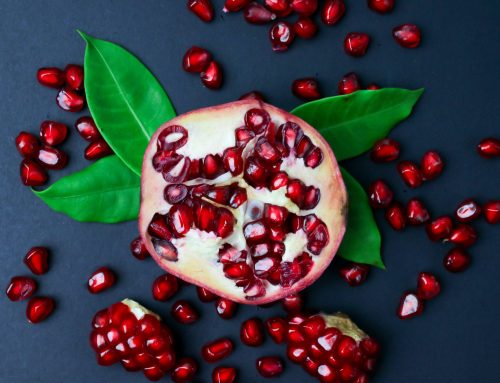Though it’s something most of us do several times per month, going to the grocery store can still be pretty intimidating for many people trying to improve their well-being through healthier food choices. That’s why we’ve created our Align Guide to Groceries! With these tips on your side, you can shop stress-free.
Know before you go
Meal planning and making a grocery list ahead of your trip will help ensure your shopping stays on track. Whether you go analog and write your list down on paper, or prefer to use your phone to keep track of needs, plan everything in advance to avoid snack aisle temptations or impulse buys.
First up—produce, produce, produce
Did you know the key element missing in most diets today is fresh fruits and vegetables? Eating plenty of produce guarantees your body is getting all the phytochemicals, nutrients, and vitamins it needs to be healthy. Here are our favorite tips for navigating the produce aisle:
- Shop SLO
Whenever you can, choose fruits and vegetables that are seasonal, local, and organic. Food that’s in season will always taste better, and is more likely to be fresh. Shopping local means there is less time between your produce being harvested and you eating it. That means you can get more nutrients out of every bite. We’ve talked about the importance of eating organic before, but choosing certified-organic groceries means you can make sure you’re getting the proper levels of phytonutrients. - Eat your rainbow
The secret to getting all the nutrients you can out of your produce is making sure your fruits and veggies are made of as many colors as possible. Deep greens, like kale or collards, will help strengthen your immune system, nourish your nervous system, and ward off depression or anxiety. Red fruits and veggies, like pomegranate or radishes support heart and brain function, especially memory. Orange fruits and vegetables are full of beta carotene and vitamin C—great for improving eye health. Yellow fruits and vegetables improve circulation. White fruits and vegetables reduce blood pressure and LDL cholesterol. Blue and purple foods are rich in antioxidants and can prevent early signs of aging and heart disease. - Get your flavors naturally
Rather than loading up on salts or artificial flavorings, opt for rich flavors that come from whole foods. Garlic, ginger, and onions are known for their anti-viral and anti-bacterial properties and they are often used as natural antibiotics. Keep fresh herbs, garlic, onions, and ginger in your kitchen year-round. In addition to offering a wide variety of nutritional benefits, these staples can take a healthy dish from bland to bravo. - Switch up your sweets
There are few things more tempting than the aisles of candy and cookies in any American grocery store. While the occasional sugary sweet is well-deserved… the key word there is occasional. Instead of artificially sweetened treats, get your sweet craving fix through sweets from the earth. Eating sweet vegetables helps reduce sweet cravings. Sweets like cookies, cakes, and ice cream can be crowded out by naturally sweet cooked vegetables like delicata squash, butternut squash, carrots, yams, sweet potatoes, and onions.
Get your protein on
We all need protein in our diets from some form. Whether you get your protein from animal or plant sources, it’s crucial for building cells, maintaining tissue integrity, and producing critical enzymes and hormones.
- Getting protein from animals
Be sure to check the dates when buying fresh animal products, and look for the terms organic, pasture-raised, and certified humane on labels. Animal products and byproducts that are certified-organic come from animals raised on organic feed without antibiotics or hormones. Pasture-raised means that the animals are allowed to roam freely and eat what is natural to them. Certified humane typically means the animals are free to behave naturally, have sufficient access to the outdoors, and slaughterers are held to higher standards, minimizing the animals’ pain. - Getting protein from plants
It’s easy to resort to highly processed imitation meat products when cutting down on animal protein. These products may seem helpful for someone transitioning from a meat-heavy diet, but it’s important to focus on natural, whole products. If you’re looking to decrease the amount of animal protein in your diet, quinoa or chia seeds may be what you’re looking for. Lentils also pack a punch of protein, standing in at 18 grams of protein per cooked cup. Chickpeas and other beans are an easy way to add protein to salads and soups. Oatmeal is a great way to start your day with a plant-based protein. - Getting protein from seafood
Seafood is another important source of protein. It’s a great source of omega-3 fatty acids, which keep our heart and brain healthy. You might want to experiment with fresh fish and seafood like salmon, cod, sardines, and mackerel. There are a few things to keep in mind though when buying and eating seafood. First, smaller fish are a better bet usually. They tend to swim closer to the surface of the water, which means they typically carry less mercury. When buying whole fish take a good look at the eyes and the gills—the eyes should be clear (not glazed over) and the gills should be red. Fish should also have tight skin and a clean smell. Fish fillets and steaks should be bright and clean in color—not murky. Always ask when the fish came into your store. If it’s been sitting on display for more than a day don’t buy it. And most importantly, buy wild caught and not farm raised fish. - Getting protein from eggs
Eggs boast a great balance of protein and fat. They’re a complete protein, which means they provide all the essential dietary amino acids the body needs. They also contain healthy amounts of vitamin D. Eggs are a great, quick, and easy way to add protein to a meal of grains and vegetables, especially if you’re on a budget! When buying eggs, look for the terms certified-organic and pasture-raised. When it comes to white eggs versus brown eggs, there’s no real difference in the quality or nutritional value. So eat the ones you like!
Let’s talk about dairy
Dairy is a topic that provokes a lot of conversation. Many people argue that dairy can lead to digestive issues, allergies, and/or mucus, while others enjoy dairy symptom free. The truth of it is that some people react badly to dairy, while some people can it eat with no problems at all. Some people can’t eat any dairy whatsoever, while some of you might realize you can only eat certain kinds or need to watch your consumption levels.
If you can eat dairy, there are some guidelines to follow.
- Once more with feeling—opt for pasture-raised, certified-organic, and grass-fed
Choose dairy that’s high-quality and follows our golden rule for shopping. Healthy cows, and other dairy producing animals, produce healthy dairy. A cow that’s pasture-raised and grass-fed will get ample time outdoors, which gives them lots of time to absorb the sunshine—a source of Vitamin D. - Ghee whiz—ghee is delicious!
Ghee is clarified butter. It can add a delicious nutty flavor to vegetables, and you can also add it to grains after they’ve been cooked.
If dairy isn’t a friend of yours or your digestive system, you still have plenty of options!
- Dairy-free milk has never been better
We are living in the boom-times of alternative milks. Nut milks are all the rage. At most grocery stores, you can find almond milk but consider trying more nut milks too like hazelnut milk or pistachio. You can also find and enjoy milk from rice, oat, or coconut. When looking for non-dairy milk, choose one that has certified organic ingredients, has the fewest number of ingredients on the label, and make sure it’s unsweetened – sweeteners can add up to 25 grams of sugar per cup!
We have much to gain from grains
Most supermarkets carry a variety of grain options, including gluten-free and/ or wheat-free items. Grains get tricky though (like most things) when it comes to marketing. Many products boast that they’re chock-full of whole grains, but a quick glance at the label reveals that very minimal grains were included in the food product. This is where your detective skills come into play! The key is finding products made from whole grains.
What are whole grains? They’re grain products where all parts of the grain are left intact.
Here are a few more tips:
- Take a grain-first approach
When you’re checking your grain’s ingredient list, you want to make sure a whole grain is the first ingredient. If the ingredients listed first look like, wheat, enriched wheat, or enriched flour—they’re trying to trick you!
• Check the ingredient list on a product claiming to be whole grain. A whole grain should be listed first in
the ingredients – not “wheat” or “enriched wheat” or “enriched flour.” - Know the whole story on whole grains
To identify a whole grain as the first ingredient in your grain, you need to know your grains! Wheat grains include bulgur, cracked wheat, spelt, and wheat berries. Wheat-free and gluten-free grains include amaranth, buckwheat, corn, millet, rice and quinoa – which
is technically a seed. Oats are inherently gluten-free, but cross-contamination during growing and processing is common so check the label if you have gluten sensitivity.
Fats are good for you—healthy fats, that is
Healthy fats are essential to good health. Fats are needed for everything from brain function to vitamin absorption. You can get great healthy fats from oils, nuts, seeds, coconut, and avocados.
When choosing oils at the store, there are a few things to keep in mind. Avoid hydrogenated and bleached oils. Select olive oil with an expiration date, olives are sourced from one country, and has a lot number. Look for brands that are cold pressed and unrefined.
Don’t be afraid to switch it up! Olive oil is delicious drizzled directly onto salads and grains. Sesame oil lends a unique, nutty flavor – you can get hot sesame oil or toasted sesame oil to mix it up and suit your taste. Coconut oil lends a smooth coconut taste. There’s also almond, avocado, and hazelnut.
Heat and light speeds up the rancidity of oils, so you never want to keep them near a window or hot stove. Keep them in a cupboard that stays cool and doesn’t get light. Also, look for oils in dark bottles when possible. Oils are great natural body moisturizers too. You can use coconut oil to prevent stretch marks and smooth the skin, avocado oil to revive dry, brittle hair, and sesame oil for a healthy massage.
Get on top of condiments
Who doesn’t love condiments? The condiment aisle is your go-to source for whatever you need to make your food taste exactly how you want. Stocking up on condiments is a great way to make sure you can always host a memorable dinner part. When cooking for a group, let guests personalize their plate by adding flavors from all the condiments you have. Condiments can be adjusted so easily, and they keep well in the fridge so you don’t have to constantly replace them. Win-win!
We do have a few suggestions, though, for shopping condiments.
- Tamari
Tamari is a gluten-free soy sauce that can be used on grains, soups, vegetables, and pretty much any recipe that calls for salt. - Seaweed flakes
Salt is delicious, but not particularly great for you. Seaweed flakes, however, are a great salt alternative. - Apple cider vinegar
Try apple cider vinegar for a sour, tangy flavor, or balsamic if you want something a little sweeter. - Nutritional yeast
Nutritional yeast is a great condiment that adds a cheesy flavor to foods and contains a lot of protein
and B vitamins. - Looking for spice or nutty flavors?
Hot peppers, sesame oil, or cayenne pepper sauce are great options for adding heat. If you’re looking for a nutty flavor, try sesame salt, tahini, or nut butters.
Flavor Town: herbs, spices, and sweeteners
Let’s get into flavors.
Herbs and spices taste great and have many powerful health benefits. Well, they have powerful health benefits when they’re unprocessed and
organic. Experiment with spices and seasonings to determine which ones you prefer. Here are our tips:
- Herbs like basil, oregano, thyme, and bay leaves complement everything from lighter fish and chicken to meats like steak and lamb. They’re also great on whole grain bread with garlic and olive oil.
- Coriander, cumin, and ginger help to reduce gas caused by beans.
- Cinnamon, cloves, coriander, ginger, cardamom, and nutmeg enhance the flavors of sweet vegetables and make them more digestible. They can also improve the digestion of dairy, fruit dishes, and desserts.
- What about salt? When shopping for salt, look for naturally harvested sea salt, which has a gray-ish tint and looks almost damp because it hasn’t been bleached and therefore retains many of its important natural qualities.
- What about sweetening? We recommend that you get whole, naturally sweet foods in your diet – this way you can satisfy a sweet tooth without deprivation. There are tons of all-natural sweeteners that can add a sweet, nutritious touch without all the chemicals. Honey is delicious, and is a great way to combat seasonal allergies, especially if you buy the local raw, unrefined type. Maple syrup is a great way to add minerals to your diet, and can add a unique flavor to more than just pancakes and waffles. Many people enjoy baking with maple syrup. Keep in mind to keep your sugar consumption to under 20 grams of sugar a day.
Feel empowered to explore your store
As you investigate the products your store has to offer, keep an open mind, experiment, and don’t be afraid to try new things. Each time you visit the supermarket, act as if it’s your first time and try something new. Check out what other people have in their carts. If it looks interesting, ask them about it – what it is, what it tastes like, and how to prepare it.
The organic and natural food industry is growing so rapidly, it’s likely you’ll find a new product every time you step into the store. We hope you’ve enjoyed our top tips for exploring the supermarket. Now it’s your turn! We challenge you to take your very own supermarket tour and develop a list of your favorite tips and tricks to share with your classmates, family members, friends, and of course your future clients.




